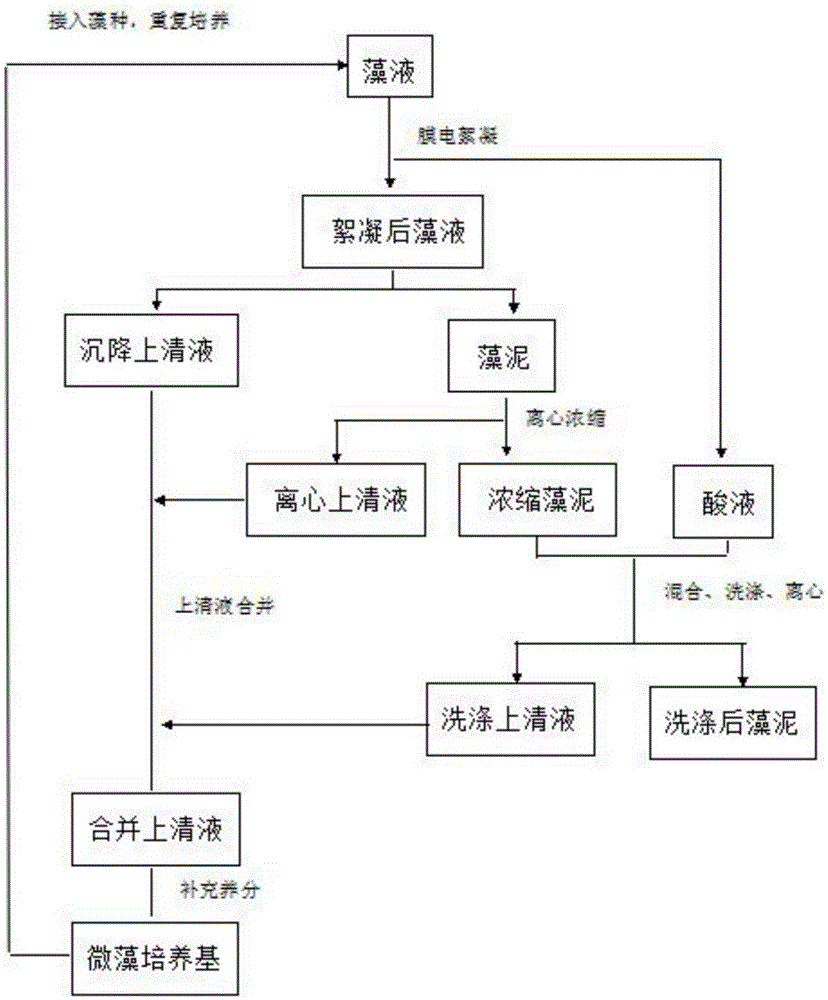A membrane electrocoagulation device and a method for harvesting microalgae using the device
A technology of electrocoagulation and microalgae, which is applied in chemical instruments and methods, single-cell algae, energy wastewater treatment, etc., can solve the problems of destroying algae cells, reducing yield, and high electrode cost, so as to improve flocculation rate and cleanliness degree of effect
- Summary
- Abstract
- Description
- Claims
- Application Information
AI Technical Summary
Problems solved by technology
Method used
Image
Examples
Embodiment 1
[0055] 1L scale microalgae membrane electrocoagulation harvesting
[0056] Materials and methods: The membrane electrocoagulation device used in this example is according to figure 1 and figure 2 And formulate. Prepare the fixed frame with plexiglass. The outer dimensions of the finished product are: 17*4*14cm (length*width*height). Put the device into the algae pool 7 with an inner size of 13.5*6.5*17.5 (length*width*height). Place 100mL0.1MNa in the anode area 3 2 SO4 solution; 50 mL of artificial seawater with a salinity of 3% is placed in the acid chamber 6 . 1L of Nannochloropsisoculata algae liquid is placed in the algae pond 7, and the biomass of the algae liquid is about 1.4g / biomass. A stainless steel mesh is used as the cathode electrode 4, and a DSE oxygen evolution electrode is used as the anode electrode 1. Electrolyze at a constant current of 0.5A for 10min, 15min, 20min, 25min, 30min, and 35min respectively. After electrolysis, put the algae solution into ...
Embodiment 2
[0070] Microalgae membrane electrocoagulation harvesting in 150L raceway pool scale
[0071] Materials and methods: The membrane electrocoagulation device was fabricated by the same method as in Example 1, and the overall dimensions were: 30*5*20cm (length*width*height). The device is placed in the algae pool 7 of the runway pool, and is radially parallel to the water flow. 0.1M Na2SO4 solution is placed in the anode area 3 until it is at the same height as the liquid level of the algae liquid; artificial seawater with a salinity of 3% is placed in the acid chamber 6 until it is at the same height as the liquid level of the algae liquid. The algae pond 7 is Nannochloropsisoculata algae liquid, and the biomass of the algae liquid is about 1.4g / biomass. A stainless steel mesh is used as the cathode electrode 4, and a DSE oxygen evolution electrode is used as the anode electrode 1. Electrolyze at a constant current of 10A for 20min, 40min, 60min, 80min, 100min, 120min, 140min, ...
Embodiment 3
[0077] Example 3 The washing effect of membrane electrocoagulation device on algae body
[0078] Materials and Methods:
[0079] As in Example 1, N. oculata was harvested by electroflocculation of microalgal membranes on a 1 L scale. The stainless steel mesh is used as the cathode electrode 4, and the DSE oxygen evolution electrode is used as the anode electrode 1, and a constant current of 2A is used for electrolysis for 5 minutes, 10 minutes, and 15 minutes respectively, and the voltage of 1L algae liquid is stable between 9.9 and 10.5 during this process. After the electrolysis, the pH of each part was measured. Then, the acid chamber 6 liquid and the algae liquid were mixed, and the other group was not mixed, centrifuged at 10,000 rpm for 6 minutes, and the supernatant was taken, and the concentration of calcium and magnesium ions and pH were measured by EDTA.2Na titration. Similarly, algae mud with two different treatments, washed and unwashed, were used for pigment con...
PUM
| Property | Measurement | Unit |
|---|---|---|
| sedimentation rate | aaaaa | aaaaa |
Abstract
Description
Claims
Application Information
 Login to View More
Login to View More - R&D
- Intellectual Property
- Life Sciences
- Materials
- Tech Scout
- Unparalleled Data Quality
- Higher Quality Content
- 60% Fewer Hallucinations
Browse by: Latest US Patents, China's latest patents, Technical Efficacy Thesaurus, Application Domain, Technology Topic, Popular Technical Reports.
© 2025 PatSnap. All rights reserved.Legal|Privacy policy|Modern Slavery Act Transparency Statement|Sitemap|About US| Contact US: help@patsnap.com



